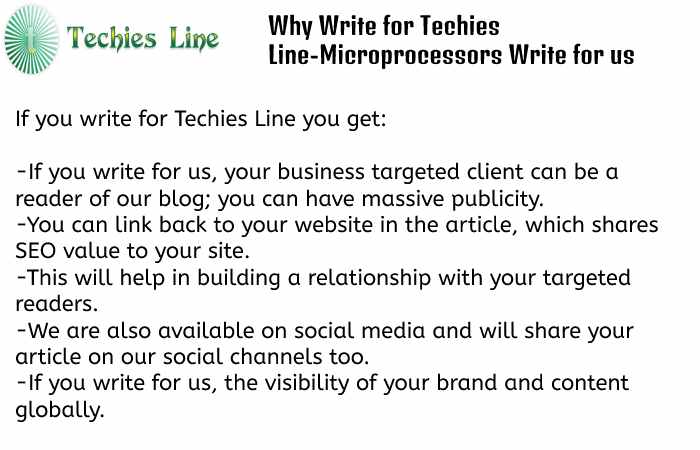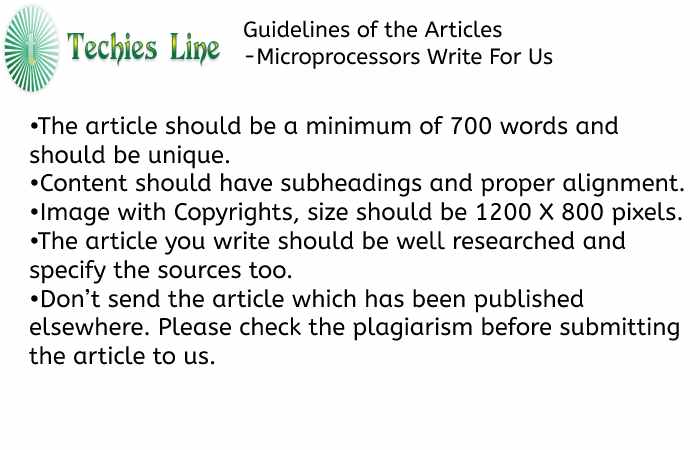Microprocessors Write for us
The computer you are using to read this page uses a microprocessor to do its job. The microprocessor is the heart of any normal computer, whether it is a desktop, server, or laptop. The microprocessor you use might be a Pentium, K6, PowerPC, Sparc, or one of the many other brands and types of microprocessors, but they all do pretty much the same thing the same way.
A microprocessor, also known as a CPU or central processing unit, is a complete computational engine that is manufactured on a single chip. The first microprocessor was the Intel 4004, introduced in 1971. The 4004 was not very powerful; all he could do was add and subtract, and he could only do those 4 bits at a time. But it was surprising that everything was on one chip. Before 4004, engineers built computers from collections of chips or discrete components (transistors connected one at a time). The 4004 powered one of the first portable electronic calculators.
If you’ve ever wondered what your computer’s microprocessor does, or if you’ve ever wondered what the differences are between types of microprocessors, read on. In this article, you’ll learn how fairly simple digital logic techniques allow a computer to do its job, whether it’s playing a game or checking the spelling of a document.
The first microprocessor to make it into a home computer was the Intel 8080, a full-on-chip 8-bit computer, introduced in 1974. The first microprocessor to hit the market was the Intel 8088, introduced in 1979 and incorporated into the PC. IBM (which first appeared around 1982). If you know the PC market and its history, you know that the PC market has grown from 8088 to 80286 to 80386 to 80486 to Pentium to Pentium II to Pentium III to Pentium 4. All of these microprocessors are made by Intel and all of them. ‘between them are improvements to the basic design of the 8088. The Pentium 4 can execute any piece of code that runs on the original 8088, but it does so about 5,000 times faster!
How To Submit Your Articles?
For Submitting Your Articles, you can email us at contact@techiesline.com, or send the demo article to the provided email address.
Why to Write for Us Techies Line – Microprocessors Write for Us

Search Terms for Microprocessors Write for Us
write for us blogging
guest blogging + “write for us.”
write for us + guest blogging
[Tech “suggest a post”]
Tech “write for us”]
[Tech “contributing writer”]
[Tech “guest article”]
[Tech “this is a guest post by”]
[Write For Us — Tech News]
[Tech Blog “submit blog post”]
[technology + “write for us” + guest post]
[technology write for us guest post]
[technology blog “write for us”]
[Write for us — Web Tech]
[Write for us — Marketing Tech News]
Technology Write For Us — Technology Blog
submit guest post technology & gadgets looking for guest posts
guest posts wanted
“guest post” or “guest blogging” or “write for us” + “farming tips”
in URL:” write-for-us.”
consulting guest blogging opportunity write for us
coaches guest blogging opportunity write for us
blogging + write for us
Having any Idea to Contribute to Web and Tech? Write for Us
Write For Us — Tech Blog
information technology write for us
technology business “write for us.”
tech blogs write for us
blogging+travel “write for us.”
guest blogging + “write for us.”
write for us + guest blogging
guest posting guidelines
become a guest blogger
become an author
suggest a post
SEO & technology “write for us.”
Digital Marketing “guest post.”
IoT write for us
guest post
write for us
writers wanted
“guest post” or “guest blogging” or “write for us” “farming tips.”
technical education cg
types of technical education
[technical education courses]
[technical education iti]
Guidelines of the Article – Microprocessors Write for Us
You can send your article to contact@techiesline.com

